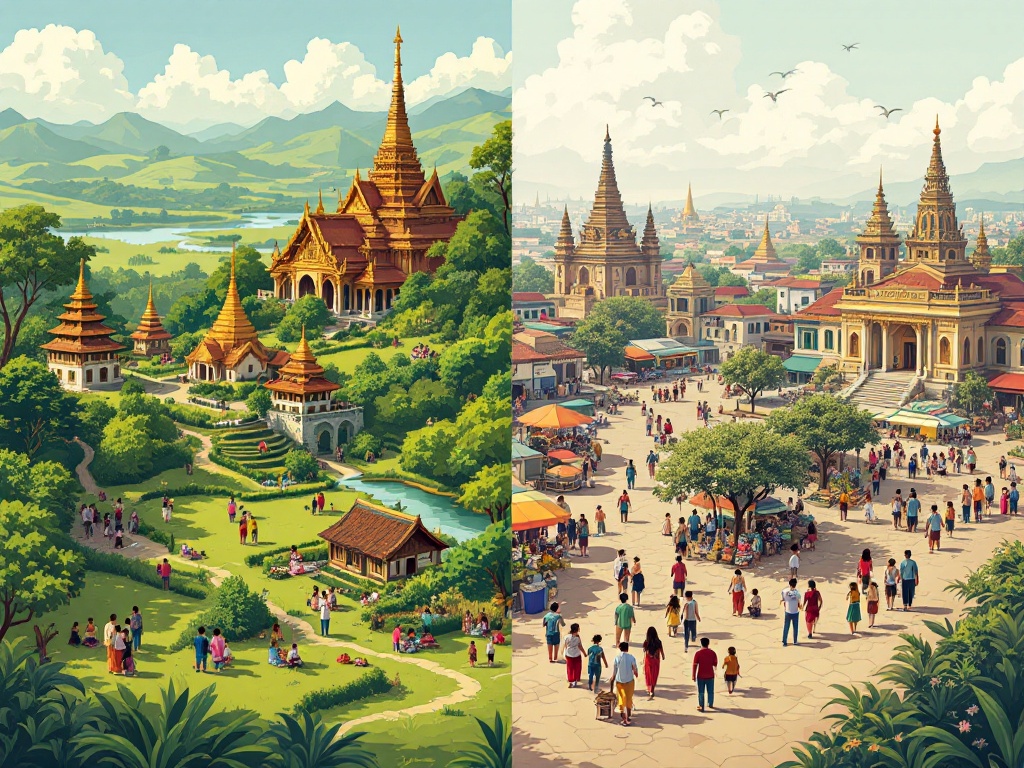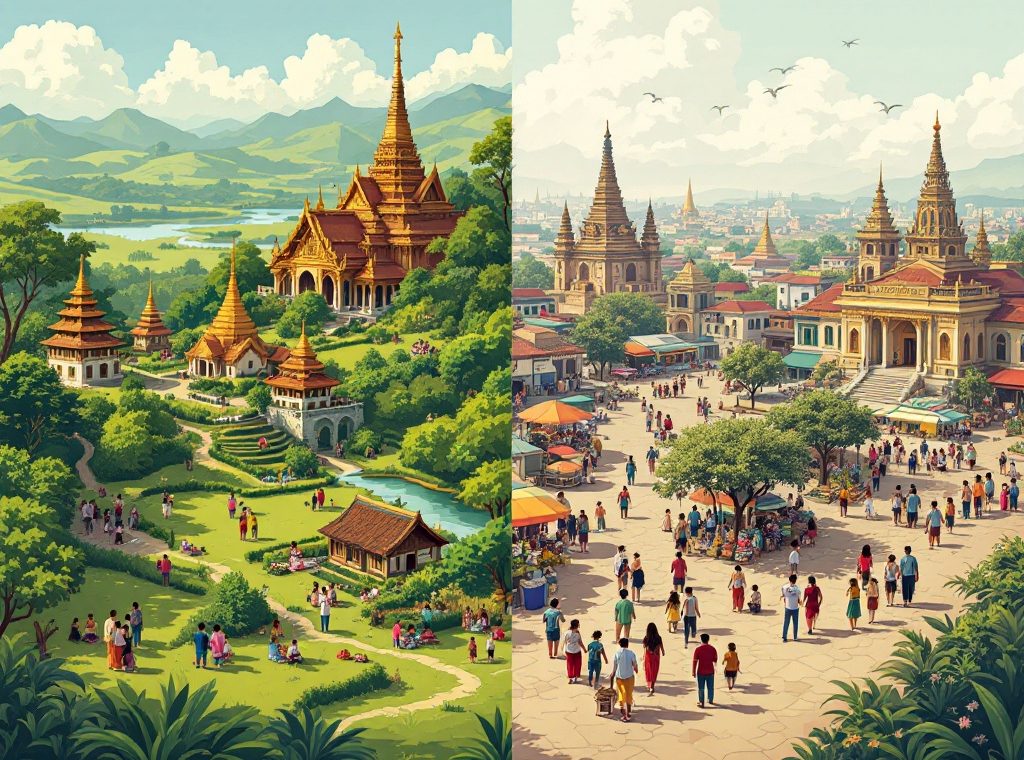The Rise and Fall of Myanmar Travel: What’s Changed?
Discover the untold story of Myanmar’s tourism, once a vibrant sector attracting over four million visitors annually, now grappling with the aftermath of a 2021 coup. Explore the breathtaking landscapes and rich cultural heritage that continue to beckon travelers, while acknowledging the significant challenges posed by political instability, ethnic conflicts, and inadequate infrastructure. Learn how these factors, coupled with the impact of the coup and subsequent military rule, have drastically reshaped the tourism landscape. Delve into the ongoing efforts to revive the industry, including a focus on domestic and heritage tourism, and consider the future prospects for travel to this captivating yet complex nation.
Important information

- Myanmar’s tourism, once thriving with over four million annual visitors, has sharply declined since the 2021 military coup.
- Political instability, violence, and safety concerns deter international travelers. Travel advisories and boycotts further impact the sector.
- Poor infrastructure, including limited transportation and unreliable internet access, hinders tourism growth.
- The government promotes domestic and heritage tourism to revitalize the industry.
- Myanmar’s tourism potential remains, linked to its rich culture and landscapes. Recovery depends on improved safety and infrastructure.
Historical Context: Myanmar’s Tourism Growth
Before 2021, Myanmar’s tourism sector thrived, attracting over four million international visitors each year. The country’s varied landscapes, ranging from bustling cities to tranquil rural areas, combined with its unique cultural heritage and ancient customs, made it a desirable travel destination.
International Air Traffic and Visitor Numbers Before 2021
Before 2021, Myanmar’s international air traffic flourished, attracting over four million visitors yearly and establishing its reputation as a growing tourist hotspot.
Myanmar’s Natural Beauty and Cultural Appeal
Myanmar, a land of captivating contrasts, invites you to discover its hidden gems. Explore the ancient city of Bagan, where thousands of Buddhist temples paint a breathtaking panorama against the horizon. Experience the serene beauty of Inle Lake, a tranquil oasis where time seems to stand still. For those seeking pristine beaches and crystal-clear waters, Ngapali awaits with its unspoiled charm. Immerse yourself in Myanmar’s rich cultural heritage, evident in the vibrant tapestry of traditional arts, historic monasteries, and magnificent pagodas. These unique attractions promise unforgettable experiences for every traveler.
Impact of the 2021 Coup and Political Instability
Myanmar’s tourism sector has been significantly impacted by military rule and geopolitical instability. The ruling State Administration Council (SAC) grapples with ethnic conflicts and political violence, further compounded by resistance from People’s Defense Forces (PDFs) and widespread civil unrest. This volatile climate has led to a sharp decline in tourism.
Military Rule and Geopolitical Tensions
The military coup in Myanmar caused significant instability, severely impacting its international relations and discouraging tourism.
State Administration Council (SAC) and Political Conflict
Following the 2021 coup, Myanmar, formerly Burma, is now ruled by the State Administration Council (SAC). However, the SAC’s legitimacy is widely disputed, both domestically and internationally, fueling ongoing conflict and raising safety concerns for potential tourists. This instability, combined with international sanctions and travel advisories targeting the SAC, has severely hampered Myanmar’s tourism sector.
Ethnic Conflict and Political Violence
Myanmar’s tourism sector faces significant challenges. Safety concerns arise from ethnic conflicts and political instability, deterring many travelers. The human rights situation, especially concerning minority groups, adds another layer of complexity, raising ethical questions for potential visitors. The military’s involvement in numerous businesses further complicates matters, making tourist spending an ethical dilemma, as it could inadvertently support the regime. Travelers must carefully consider these factors before visiting Myanmar.
People’s Defense Forces (PDFs) and Civil Unrest
The armed resistance by the People’s Defense Forces (PDFs) against Myanmar’s military junta fuels the country’s unrest and creates a volatile security situation. This makes travel perilous and severely impacts tourism. The ongoing conflict has deterred many visitors, effectively shutting down the tourism industry, as Myanmar is considered too dangerous.
Challenges in Myanmar’s Tourism Sector
Myanmar’s tourism sector faces severe challenges due to the combined impact of the COVID-19 pandemic and the 2021 military coup. Tourist arrivals have drastically decreased, significantly impacting businesses and the national economy. Many tour operators have closed, while surviving businesses operate with minimal activity.The military government and martial law deter international tourism. Many countries advise against travel to Myanmar due to safety concerns, forcing the nation to depend more on domestic tourism, which remains far below pre-crisis levels. Access to many tourist sites, particularly in border and conflict zones, is restricted.Political instability and security risks create major obstacles. Frequent clashes between the military and resistance groups, along with widespread violence and displacement, foster a volatile environment. This instability discourages travel, compounded by disruptions to travel routes and essential services.Inadequate infrastructure further hinders tourism. Outdated transportation, limited accommodations, and unreliable visa-on-arrival programs create obstacles for potential visitors. Unpredictable land border crossings and unclear permit requirements pose additional challenges.Health and safety concerns, including COVID-19 and the ongoing conflict, deter travelers. Limited healthcare access in certain areas adds to these worries. Deteriorating infrastructure in popular destinations like Bagan and Inle Lake worsens the situation.
Tourism Collapse and Economic Crisis
Myanmar’s tourism sector collapsed after the COVID-19 travel restrictions and the 2021 coup, sparking a significant economic crisis. Businesses and communities reliant on tourism struggled as political instability and conflict deterred international visitors, exacerbating the downturn. The industry’s contribution to Myanmar’s GDP plummeted, forcing many tourism-related businesses to close and resulting in widespread job losses.
Impact of Military Government and Martial Law
Myanmar’s tourism sector has suffered a devastating blow due to martial law and the military government’s subsequent actions. This has led to a sharp decline in visitor numbers, further destabilizing the economy and inflicting substantial damage.
Political Instability and Security Concerns
Political instability deters tourism, as travelers prioritize safety. This uncertain climate discourages visits, impacting local businesses that depend on tourist spending. Consequently, travelers opt for safer alternatives. The February 2021 coup in Myanmar exemplifies this trend. The resulting unrest and safety concerns caused international tourism to plummet, damaging the country’s reputation and desirability as a travel destination. For example, the aftermath of the coup saw a significant decrease in tourist arrivals, impacting local economies and livelihoods. Safety and stability are paramount for a thriving tourism sector.
Infrastructure Development and Travel Logistics
Myanmar’s tourism sector faces significant challenges due to underdeveloped infrastructure and difficult travel logistics. Roads are often in poor condition, and domestic flights are limited. The scarcity of transportation options makes navigating between destinations a time-consuming and arduous process, negatively impacting the overall visitor experience. Moreover, these infrastructure limitations restrict access to many regions, hindering tourism growth. Strategic improvements in infrastructure and transportation would significantly enhance Myanmar’s tourism potential.
Health and Safety Concerns
Travelers prioritize safety, and concerns such as COVID-19, inadequate infrastructure, and political instability significantly impact their decisions. The pandemic created widespread uncertainty, further compounded by ongoing political unrest. These factors discourage tourism. Outdated infrastructure presents additional safety hazards. Therefore, destinations must address these concerns to attract visitors.
Travel Restrictions and Guidelines
Navigating visa applications for Myanmar can be challenging due to the country’s evolving political landscape. While some Southeast Asian nations may offer visa exemptions, these are subject to change. Border restrictions are also fluid, impacting international travel. For the latest details, consult official government resources and stay well-informed.
Visa Challenges and Exemptions for ASEAN Countries
Myanmar has reinstated visa-free access for ASEAN nationals to boost tourism and streamline travel. However, land border closures can be unpredictable, and crossing permits are sometimes confusing. To avoid visa issues, tourists should use the same entry and exit points. Alternatively, a Tourist eVisa is available for citizens of 100 countries.
Border Restrictions and International Travel Impacts
Traveling to Myanmar presents difficulties due to political instability and safety concerns. Many countries advise against travel to Myanmar and have implemented border closures, making entry challenging. These restrictions have severely impacted international tourism, leading to a significant decline. The limited availability of commercial flights further complicates travel to the country.
Efforts to Revive Myanmar’s Tourism
Myanmar is striving to revitalize its tourism industry, but encounters obstacles due to political instability and safety concerns, leading to travel boycotts. To address these challenges, the government is implementing a new approach. Instead of depending on international tourism, they are encouraging domestic travel and emphasizing visits to Myanmar’s cultural heritage sites. This shift represents a novel strategy to attract visitors.
Government Revival Efforts and Tourism Boycotts
Myanmar’s government is eager to revive its tourism industry. However, international boycotts, prompted by the nation’s political instability and human rights abuses, are hindering these efforts, creating significant challenges for the sector’s recovery.
Domestic Tourism and Heritage Tourism Potential
Myanmar’s domestic tourism sector has contracted sharply due to the combined effects of the pandemic and the 2021 coup. However, a potential lifeline lies in heritage tourism, which emphasizes local culture and history and attracts a domestic audience, offering a chance to revitalize local economies.
Future Prospects for Myanmar Travel
Myanmar’s tourism industry depends on infrastructure development and successful revitalization efforts. The country faces challenges such as limited accommodations, underdeveloped transportation, and unreliable internet access. Political instability and safety concerns also deter potential tourists. However, Myanmar has significant potential thanks to its rich cultural heritage and diverse landscapes, including its famous ancient temples. With improved stability and infrastructure, the tourism sector could flourish. Promoting domestic and heritage tourism could also contribute to the industry’s recovery.
Challenges
- limited accommodations,
- underdeveloped transportation,
- unreliable internet access,
- political instability,
- safety concerns.
Opportunities
- rich cultural heritage,
- diverse landscapes,
- famous ancient temples,
- potential for domestic tourism,
- potential for heritage tourism.
Tourism Revival Efforts and Infrastructure Challenges
Tourism has been significantly impacted by damaged infrastructure, including limited internet access, which creates obstacles for communication and travel. Potential visitors are understandably worried about safety due to the concerning political climate.
Rebuilding the tourism industry requires not only reliable infrastructure like roads and internet access but also addressing crucial safety issues stemming from political instability. These improvements will encourage travel, ease visitor concerns, and ultimately attract tourists back to the region.
Potential for Increased Tourist Arrivals
Myanmar welcomed 233,487 international tourists in 2022, a slight increase that hints at a possible tourism resurgence. This potential growth depends heavily on improvements in safety and political stability. The country’s stunning landscapes and rich culture continue to attract visitors. However, challenges remain, including the need for infrastructure development and ongoing safety issues. A resolution to the political crisis is crucial for Myanmar to fully realize its tourism potential.

















